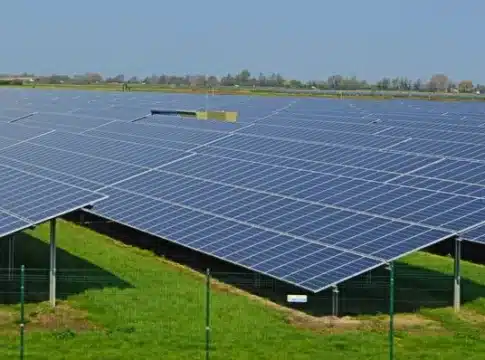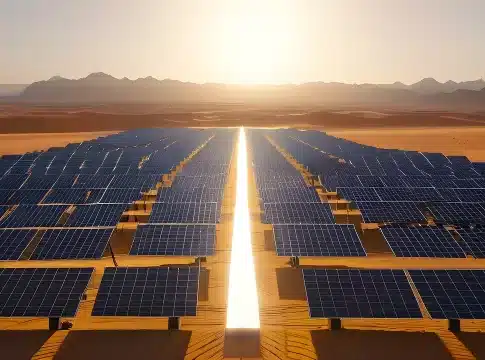FERC Grants Waiver for Solar Project Amidst Local Resistance
The Federal Energy Regulatory Commission (FERC) has granted a waiver to PJM Interconnection LLC, allowing a 210-MW solar project in Indiana to relocate to a different location on the same transmission line. Despite objections from PJM and Commissioner Mark Christie, the waiver was approved, enabling the Rush Solar Project II to proceed with its plans.
Originally intended for Rush County, the solar project faced setbacks. The county, along with neighboring Fayette County, imposed moratoriums on solar permit applications until at least January 2025. In response, Rush Solar sought permission to move the project to Dearborn County under alternate site provisions in PJM’s grid connection study process.
Local Land Concerns and Regulatory Hurdles
The challenges encountered by Rush Solar highlight local land concerns in states like Indiana. This is where renewable energy policy is not uniformly addressed at the state level.
Brian Flory of Solar United Neighbors noted the diverse county policies regarding solar power, with some counties welcoming it while others oppose it.
Indiana’s agricultural landscape, with a significant portion of corn production going to ethanol, adds complexity to the debate. Concerns over land use changes, particularly the conversion of farmland to solar farms, have led to resistance from residents.
PJM objected to the waiver, citing conflicts with interconnection queue reforms and questioning Rush Solar’s good faith in seeking the waiver. PJM argued that granting the waiver could set a precedent for circumventing site control requirements. And it may also delay grid studies for other projects in the interconnect queue.
Despite these objections, FERC approved the waiver, allowing Rush Solar to proceed with its solar project in Dearborn County. The decision underscores the complexities and challenges of renewable energy development at the local level amidst evolving regulatory landscapes.
Just for April, several states involving large renewable developers have made significant strides in advancing massive solar projects. Virginia, Illinois, and Texas have approved solar projects, boosting their renewable energy supply.
READ MORE: Harnessing the Sun: America’s Solar Snapshot in April 2024
FERC’s Decision and Dissenting Voice
In an April 5 order, the majority of the FERC determined that Rush Solar met the criteria for a waiver, despite objections from PJM Interconnection LLC. The commission concluded that Rush Solar acted in good faith, engaged with local officials, and pursued alternative sites only after the county moratoriums were imposed.
FERC stated that the waiver was limited in scope. It allows Rush Solar to change the project site to a non-adjacent alternate site while remaining subject to other site control verification requirements.
The commission rejected PJM’s concern that granting the waiver would encourage circumvention of site control requirements, noting that Rush Solar had originally intended to locate the project in Rush County.
However, Commissioner Mark Christie dissented, arguing that the majority disregarded the more stringent site control requirements approved for PJM in November 2022. He expressed concern that the order failed to adequately justify granting the waiver.
Moreover, it could undermine efforts to reduce speculative projects and grid connection study delays.
Corporate Support and Community Solar Growth
The corporate world in the U.S. is also keen on supporting the unstoppable rise of solar power.
A White House report reveals plans for the announcement of over 100 gigawatts (GW) of solar module manufacturing capacity. This capacity could potentially produce enough solar panels to power approximately 10% of homes in the U.S., amounting to over $13 billion in investments.
Apart from Amazon which is leading the pack of renewable giants, startups are also making waves in this revolution.
Boston-based Nexamp Inc. has secured $520 million in funding to bolster its national portfolio of community solar projects. Led by Manulife Investment Management Ltd., the capital raise also saw participation from existing investors Diamond Generating Corp. and Generate Capital PBC.
Community solar projects offer consumers the benefits of onsite solar generation without the complexities of rooftop solar. This enables them to earn credits on their power bills by owning or subscribing to a portion of a community solar farm.
This electricity model is gaining traction in the US, with 6.5 GW of community solar arrays already installed, according to the Solar Energy Industries Association. The association predicts an additional 6 GW of capacity will be added to the community solar market over the next five years.
Nexamp’s latest funding round highlights the crucial role of community solar in providing clean and affordable energy solutions to all Americans, remarked CEO Zaid Ashai.
RELATED: US EPA to Invest $20B in Climate and Clean Energy Projects for Underserved Communities
Nexamp currently serves over 80,000 customers and manages a 1.5-GW portfolio, including projects in progress. The company intends to expand its capacity by multiple gigawatts in the coming years, aiming to provide power to over a million customers.
The post FERC Grants Waiver for Solar Project Amidst Local Resistance appeared first on Carbon Credits.



